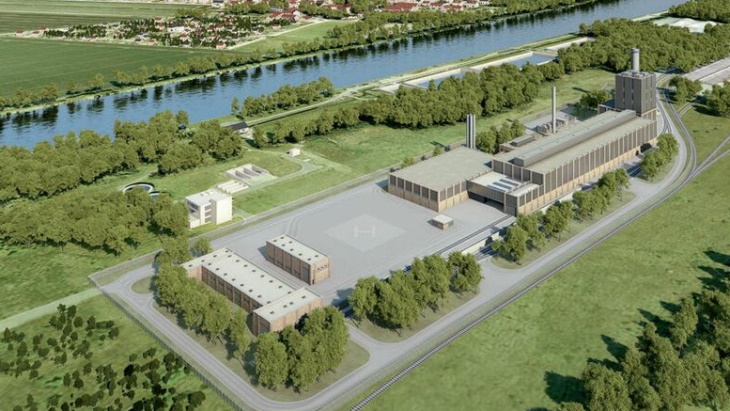Germany's federal radioactive waste company, Bundesgesellschaft für Endlagerung (BGE), has awarded Hanover-based construction firm Ed Züblin AG a contract to construct the radioactive waste reloading hall at the Konrad repository in Salzgitter, Lower Saxony.

How the Konrad repository site could appear (Image: BGE)
BGE said Züblin was awarded the contract following a Europe-wide award procedure. It noted four other companies had also met the eligibility criteria for participation in the procedure for the complex construction project.
With a total length of 140 metres, the reloading hall with the attached buffer hall on the site of the Konrad 2 mine will be the largest building to be constructed. The start of construction for the reloading hall is scheduled for the first quarter of 2023, with completion planned for 2025. Low and intermediate-level waste (LLW/ILW) is scheduled to arrive and be repackaged in the facility from 2027.
In the building complex, the delivered packages with LLW/ILW will be radiologically checked, lifted off trucks and rail wagons and prepared for transport underground through the Konrad 2 storage shaft. The buffer hall, which is directly connected to the reloading hall, can accommodate containers at short notice in the event of unplanned stoppages of the shaft hoisting system.
The construction of the earthquake-proof building will be supervised by various authorities. The Federal Office for the Safety of Nuclear Waste Management is responsible for supervision under nuclear law.
Konrad - a former iron-ore mine - will be Germany's first repository for low and intermediate-level waste. The mine closed for economic reasons in 1976 and investigations began the same year to determine whether the mine was suitable for use as a repository for LLW/ILW.
In 2002, the Lower Saxony Ministry for the Environment issued a planning approval decision for the Konrad repository. Following multiple legal proceedings, this approval was confirmed by the Federal Administrative Court in 2007. A construction licence was issued in January 2008.
In April 2017, BGE assumed responsibility as the operator of the Asse II mine and the Konrad and Morsleben repositories from the Federal Office for Radiation Protection.
The Konrad mine is being converted for use as a repository under the supervision of BGE. The two mine shafts are being renovated and equipped with the necessary infrastructure underground. Among other things, this infrastructure includes transport galleries and the emplacement areas at a depth of around 850 metres. Above ground, construction work is underway on new buildings, including the reloading hall.
The conversion of Konrad Shaft 2 for bringing containers underground began in 2017 with the construction of the shaft bottom (the underground transfer station for the waste containers). This phase of construction is already at an advanced stage. Construction of the winding tower has also been allocated to a contractor, and the tower is due to be completed in 2026.
In the mine itself, the chambers for the start of emplacement operations have been fully excavated. The mine openings for infrastructure, such as the workshop in the control area and the offset processing facility, are currently being excavated at six faces simultaneously and are at an advanced stage of completion. The underground infrastructure (ventilation technology, water supply and disposal, traffic guidance, etc) is in the final stage of planning.
Konrad will initially take some 300,000 cubic metres of waste - 95% of the country's waste volume, with 1% of the radioactivity. At present, this waste is stored above-ground in interim storage facilities and at state collection points. DBE plans for Konrad eventually to accommodate 650,000 cubic metres of waste from the operation and decommissioning of nuclear power plants as well as from industry, medicine and research. It was initially expected to be operational by 2014 with storage chambers on six levels from 800 to 1300 metres depth but has been delayed.
Under Germany's National Programme, announced in August 2015, two locations are proposed for the final disposal of radioactive waste: Konrad for LLW/ILW and another as yet undetermined site for high-level waste. The programme does not seek an extension to the Konrad repository, so the second location will need to accommodate all radioactive waste produced by the end of this year, when the country's last nuclear power reactor is set to shut under the government's nuclear phase-out policy.
Researched and written by World Nuclear News